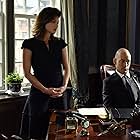Asiana flight no.214 crashes on approach to San Francisco.Asiana flight no.214 crashes on approach to San Francisco.Asiana flight no.214 crashes on approach to San Francisco.
Jonathan Aris
- Narrator
- (voice)
Stephen Bogaert
- Narrator
- (voice)
Chris Gillett
- NTSB Investigator Roger Cox
- (as Chris Gillet)
Nicolas Van Burek
- Ben Levy
- (as Nicholas Van Burek)
Featured review
An Asianair flight from Seoul to San Francisco approaches the airport normally, on a beautiful sunny day. The runway extends out into San Francisco Bay, surrounded by a low wall of rocks. The airline clips the seawall with its tail and crashes, with two fatalities.
Why? The airplane's remains are thoroughly checked and all are in good operating condition. The immediate cause of the crash is determined to be pilot error.
The pilot and co-pilot had thousands of hours of flying behind them but lacked training in manually landing the Boeing 777. The pilot relied too much on automation and when he tried to assume manual control he made a series of fundamental mistakes that led to the disaster.
The opinions of the investigating team were divided. On one side was the belief that the captain is ultimately responsible for whatever happens on the airplane and should be thoroughly familiar with all his controls and instruments.
On the other side, some of the team pointed to the complexity of the instrument panel, with its superabundance of signals and switches, and made note of the fact that the captain was still in training on the 777 and had done most of his previous flying on an Airbus, which has a very different configuration of automation controls.
The question it all raises is implicit. Can technology lead to automation so sophisticated that the human element is -- if not removed -- rendered less necessary? I'll give two examples of extractive industries where the question assumes economic importance. (1) We used to locate schools of tuna by sight and bring them in one at a time with poles. Now we locate them by sonar and sweep them up en masse. (2) The coal industry is dying before our eyes because the human miners are being replaced by man-machine systems, among other reasons.
There seems to be little we can do to stop or slow down the trend, even if it were desirable. So who is in the saddle? And do we know how to ride the horse?
Why? The airplane's remains are thoroughly checked and all are in good operating condition. The immediate cause of the crash is determined to be pilot error.
The pilot and co-pilot had thousands of hours of flying behind them but lacked training in manually landing the Boeing 777. The pilot relied too much on automation and when he tried to assume manual control he made a series of fundamental mistakes that led to the disaster.
The opinions of the investigating team were divided. On one side was the belief that the captain is ultimately responsible for whatever happens on the airplane and should be thoroughly familiar with all his controls and instruments.
On the other side, some of the team pointed to the complexity of the instrument panel, with its superabundance of signals and switches, and made note of the fact that the captain was still in training on the 777 and had done most of his previous flying on an Airbus, which has a very different configuration of automation controls.
The question it all raises is implicit. Can technology lead to automation so sophisticated that the human element is -- if not removed -- rendered less necessary? I'll give two examples of extractive industries where the question assumes economic importance. (1) We used to locate schools of tuna by sight and bring them in one at a time with poles. Now we locate them by sonar and sweep them up en masse. (2) The coal industry is dying before our eyes because the human miners are being replaced by man-machine systems, among other reasons.
There seems to be little we can do to stop or slow down the trend, even if it were desirable. So who is in the saddle? And do we know how to ride the horse?
- rmax304823
- Feb 25, 2017
- Permalink
Storyline
Did you know
- TriviaThe 777 depicted in the reenacted animation showed RR engines. In actual fact, the ill-fated plane was equipped with PW engines.
- ConnectionsFeatured in Air Crash Investigation: Runway Runoff (2019)
Details
Contribute to this page
Suggest an edit or add missing content












